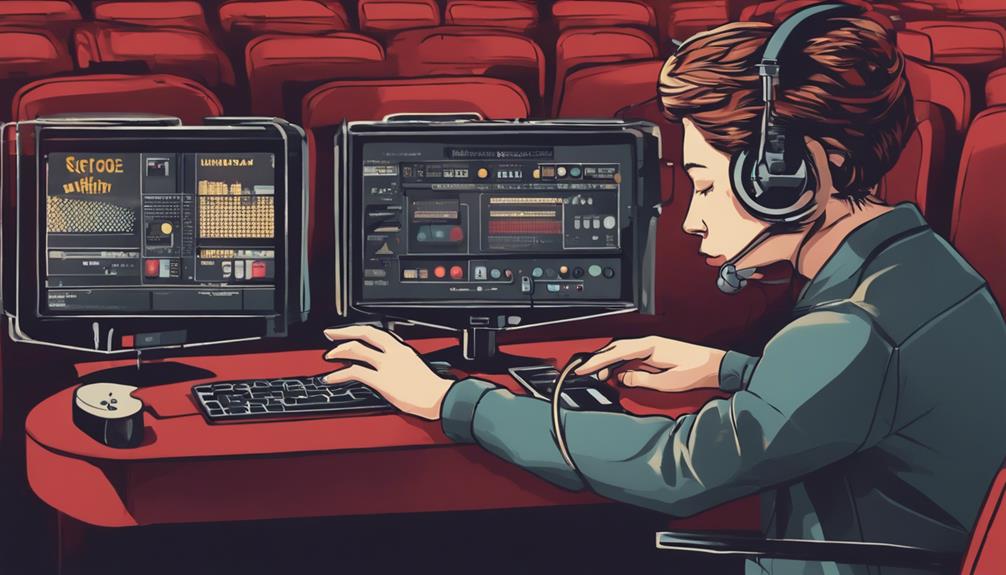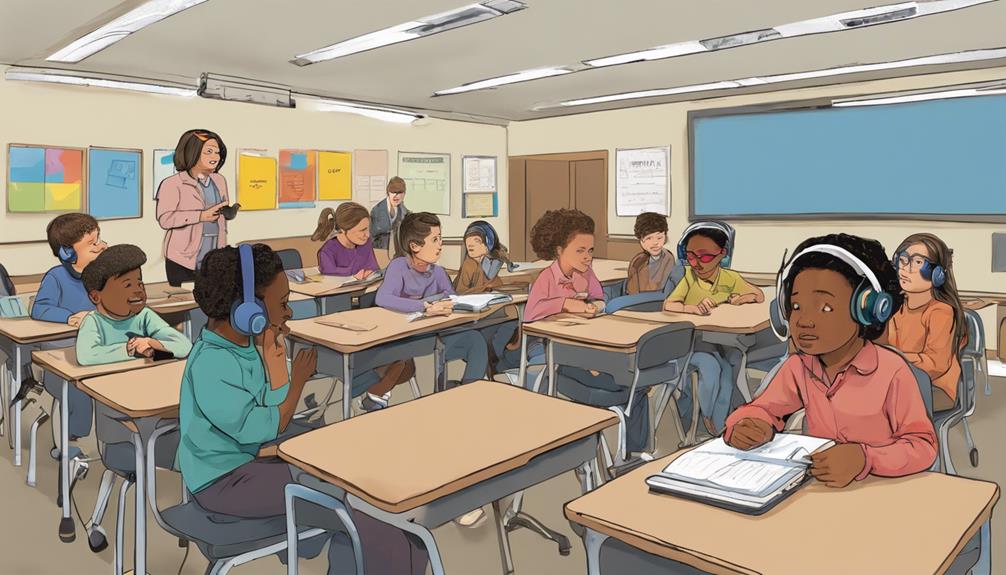When looking into the different assistive listening devices available for movie theaters, it is important to carefully consider the various options.
The selection process can seem overwhelming at first glance, but fear not, for we are here to guide you through the maze of choices.
From evaluating sound quality to exploring user-friendly features, we'll provide you with expert insights on how to make an informed decision that enhances your movie experience.
So, let's embark on this journey together and unravel the secrets to choosing the best assistive listening device for your next cinematic adventure.
Key Takeaways
- Consider compatibility with personal hearing devices for optimal sound reception.
- Evaluate sound quality for enhanced dialogue comprehension and immersive experience.
- Prioritize user-friendly features like adjustable volume and tone settings.
- Seek expert recommendations from audiologists for a fulfilling cinematic experience.
Understanding ALD Options
When exploring the realm of movie theater assistive listening devices, understanding the diverse range of ALD options becomes paramount for an enriched cinematic experience. Hearing plays a crucial role in our ability to fully engage with the soundscapes of movies.
In theaters, ALDs such as induction loop systems, infrared systems, FM systems, and Bluetooth-enabled devices are available to enhance the listening experience for individuals with hearing loss. These devices work by receiving signals from the theater's audio source and transmitting sound directly to the user's hearing aid or personal device.
For those seeking improved dialogue comprehension and overall sound clarity, selecting the right ALD is essential. Different theaters may utilize various systems, so compatibility with personal hearing devices is key for optimal performance. ALDs in theaters cater to a variety of hearing aids, allowing users to customize settings to suit their preferences and ensure a more enjoyable movie-watching experience.
Evaluating Sound Quality

Assessing the sound quality of movie theater assistive listening devices is crucial for optimizing the auditory experience for individuals with hearing loss. When evaluating sound quality in these devices, it's essential to consider the following:
- Speech Intelligibility: Look for devices that enhance speech clarity, making it easier to follow dialogue and understand the movie's storyline. Devices with advanced speech intelligibility features can significantly improve the overall movie-watching experience.
- Sound Clarity: Opt for devices that offer clear and crisp audio quality. High-quality sound reproduction can make a difference in how well you enjoy the movie, providing a more immersive experience.
- Volume Control: Choose devices that allow for personalized volume adjustments to suit your hearing preferences. Having control over the volume ensures that you can set it at a comfortable level without missing any important dialogues or sound effects. Selecting a device with adaptable volume settings is key to customizing your listening experience in the theater.
Considering Compatibility
To ensure a seamless integration with your personal hearing device, it's essential to consider the compatibility of the movie theater's assistive listening devices. When selecting a theater, check if their devices are compatible with your specific hearing aid or cochlear implant.
It's crucial that the assistive listening devices support the telecoil function, allowing for direct sound transmission to your hearing device. The presence of induction loop systems in theaters can enhance your experience by providing optimal sound reception through your hearing aid's telecoil feature.
Confirm that the theater's assistive listening devices align with the technology and settings of your personal hearing device to tailor the experience to your needs. Opt for theaters offering a range of assistive listening devices to cater to various types of hearing aids and preferences, ensuring you can make the most of your movie-watching experience.
Exploring User-Friendly Features

Exploring user-friendly features enhances the usability of assistive listening devices, catering to individual preferences and improving the overall movie-watching experience. When considering listening devices for theaters, it's crucial to look for features that promote ease of use and customization. Here are three key user-friendly features to prioritize:
- Volume Control: Opt for devices that offer adjustable volume settings to personalize sound levels according to your comfort and hearing needs. This feature allows you to enjoy the movie at the perfect audio level without disturbing others.
- Adjustable Tone Settings: Look for devices with adjustable tone settings that enhance clarity based on your preferences. This feature can make dialogue and sound effects more distinct and enjoyable, providing a tailored listening experience.
- Wireless Connectivity: Choose devices with wireless connectivity options for seamless pairing with your personal devices. This feature enables you to connect the assistive listening device to your smartphone or tablet effortlessly, giving you more control and flexibility during the movie.
Seeking Expert Recommendations
Drawing upon the expertise of audiologists can significantly enhance the selection process of optimal assistive listening devices for movie theaters.
Audiologists, as professionals specialized in hearing health, can provide expert recommendations tailored to individual needs. Their guidance ensures that assistive devices are compatible with personal hearing aids or cochlear implants, maximizing their effectiveness in addressing hearing loss concerns within movie theater settings.
By seeking expert recommendations, individuals with hearing loss can enhance their overall movie theater experience and achieve optimal utilization of assistive listening technology.
Consulting with audiologists not only aids in selecting the most suitable devices but also contributes to a more personalized and effective approach to managing hearing difficulties in public entertainment venues.
Partnering with audiologists for expert advice when choosing assistive listening devices for movie theaters can lead to a more fulfilling and inclusive cinematic experience for those with hearing impairments.
Frequently Asked Questions
What Is the Most Commonly Used Assistive Listening Device?
The most commonly used assistive listening device is the closed captioning device. It provides text display for individuals with hearing loss and is widely available in theaters.
Patrons use closed captioning devices to enhance their movie-watching experience, especially those who rely on visual cues for dialogue. It's an essential accessibility option for many moviegoers.
How Can I Hear Better at a Movie Theater?
To hear better at a movie theater, we can explore various assistive listening devices like infrared systems, closed captioning, and personal amplification systems. These technologies can enhance sound clarity and provide text display for improved dialogue comprehension.
Additionally, induction loop systems offer direct sound transmission for hearing aid users. Researching theaters with advanced assistive technology can help us select the best movie experience tailored to our hearing needs.
What Is an Assistive Listening Device for Theater?
Assistive listening devices for theaters are tools that aid individuals with hearing loss in enjoying movie screenings. They include headphones, neck loops, and closed captioning systems. These devices transmit audio signals directly to the user's hearing aids or headphones.
The goal is to ensure all movie enthusiasts, regardless of hearing abilities, have equal access to audio content. This enhances the overall movie-going experience for patrons with hearing impairments.
What Is the Best Sound Seat in a Movie Theater?
We always aim for the center seats in a movie theater for the most balanced audio experience. It's best to steer clear of the speakers to enjoy a more comfortable sound level.
Sitting too close to the screen can be overwhelming, so we suggest finding a sweet spot for optimal enjoyment. While balcony seats offer a unique perspective, the audio quality mightn't always be the best.
Some theaters even have special sound-enhanced seats for the ultimate auditory immersion.
Conclusion
In conclusion, choosing the right movie theater assistive listening device can greatly enhance the movie-watching experience for those with hearing impairments.
Did you know that approximately 15% of adults in the United States report some trouble hearing?
By selecting a device that meets your specific needs and preferences, you can enjoy clear and immersive audio while watching your favorite films at the theater.
Remember to research your options and seek expert recommendations to make the best choice.











